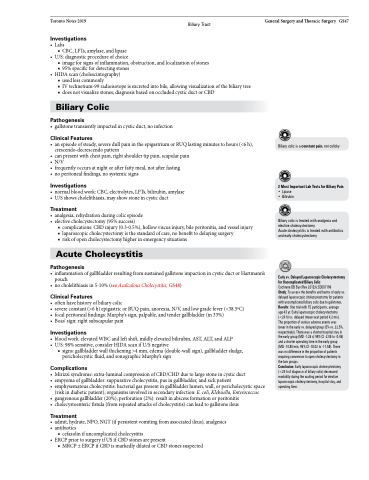Page 449 - TNFlipTest
P. 449
Toronto Notes 2019 Biliary Tract
Investigations
• Labs
■ CBC, LFTs, amylase, and lipase
• U/S:diagnosticprocedureofchoice
■ image for signs of inflammation, obstruction, and localization of stones ■ 95% specific for detecting stones
• HIDAscan(cholescintography)
■ used less commonly
■ IV technetium-99 radioisotope is excreted into bile, allowing visualization of the biliary tree ■ does not visualize stones; diagnosis based on occluded cystic duct or CBD
Biliary Colic
Pathogenesis
• gallstonetransientlyimpactedincysticduct,noinfection
Clinical Features
• anepisodeofsteady,severedullpainintheepigastriumorRUQlastingminutestohours(<6h), crescendo-decrescendo pattern
• canpresentwithchestpain,rightshouldertippain,scapularpain
• N/V
• frequentlyoccursatnightorafterfattymeal,notafterfasting
• noperitonealfindings,nosystemicsigns
Investigations
• normalbloodwork:CBC,electrolytes,LFTs,bilirubin,amylase • U/Sshowscholelithiasis,mayshowstoneincysticduct
Treatment
• analgesia,rehydrationduringcolicepisode • electivecholecystectomy(95%success)
■ complications: CBD injury (0.3-0.5%), hollow viscus injury, bile peritonitis, and vessel injury ■ laparoscopic cholecystectomy is the standard of care, no benefit to delaying surgery
■ risk of open cholecystectomy higher in emergency situations
Acute Cholecystitis
Pathogenesis
• inflammationofgallbladderresultingfromsustainedgallstoneimpactionincysticductorHartmann’s pouch
• nocholelithiasisin5-10%(seeAcalculousCholecystitis,GS48)
Clinical Features
• oftenhavehistoryofbiliarycolic
• severeconstant(>6h)epigastricorRUQpain,anorexia,N/V,andlowgradefever(<38.5oC) • focalperitonealfindings:Murphy’ssign,palpable,andtendergallbladder(in33%)
• Boas’sign:rightsubscapularpain
Investigations
• bloodwork:elevatedWBCandleftshift,mildlyelevatedbilirubin,AST,ALT,andALP • U/S:98%sensitive,considerHIDAscanifU/Snegative
■ signs: gallbladder wall thickening >4 mm, edema (double-wall sign), gallbladder sludge, pericholecystic fluid, and sonographic Murphy’s sign
Complications
• Mirizzisyndrome:extra-luminalcompressionofCBD/CHDduetolargestoneincysticduct
• empyemaofgallbladder:suppurativecholecystitis,pusingallbladder,andsickpatient
• emphysematous cholecystitis: bacterial gas present in gallbladder lumen, wall, or pericholecystic space
(risk in diabetic patient); organisms involved in secondary infection: E. coli, Klebsiella, Enterococcus • gangrenousgallbladder(20%),perforation(2%):resultinabscessformationorperitonitis
• cholecystoentericfistula(fromrepeatedattacksofcholecystitis)canleadtogallstoneileus
Treatment
• admit,hydrate,NPO,NGT(ifpersistentvomitingfromassociatedileus),analgesics • antibiotics
■ cefazolin if uncomplicated cholecystitis
• ERCPpriortosurgeryifUSifCBDstonesarepresent
Biliary colic is a constant pain, not colicky
2 Most Important Lab Tests for Biliary Pain
• Lipase • Bilirubin
Biliary colic is treated with analgesia and elective cholecystectomy
Acute cholecystitis is treated with antibiotics and early cholecystectomy
Early vs. Delayed Laparoscopic Cholecystectomy for Uncomplicated Biliary Colic
Cochrane DB Syst Rev 2013;6:CD007196
Study: To assess the benefits and harms of early vs. delayed laparoscopic cholecystectomy for patients with uncomplicated biliary colic due to gallstones. Results: One trial with 75 participants, average
age 43 yr. Early laparoscopic cholecystectomy (<24 h) vs. delayed (mean wait period 4.2 mo). The proportion of serious adverse events was lower in the early vs. delayed group (0% vs. 22.5%, respectively). There was a shorter hospital stay in the early group (MD -1.25 d, 95% CI -2.05 to -0.45) and a shorter operating time in the early group (MD -14.80 min, 95% CI -18.02 to -11.58). There was no difference in the proportion of patients requiring conversion to open cholecystectomy in the two groups.
Conclusion: Early laparoscopic cholecystectomy (<24 h of diagnosis of biliary colic) decreased morbidity during the waiting period for elective laparoscopic cholecystectomy, hospital stay, and operating time.
General Surgery and Thoracic Surgery GS47
■ MRCP ± ERCP if CBD is markedly dilated or CBD stones suspected


